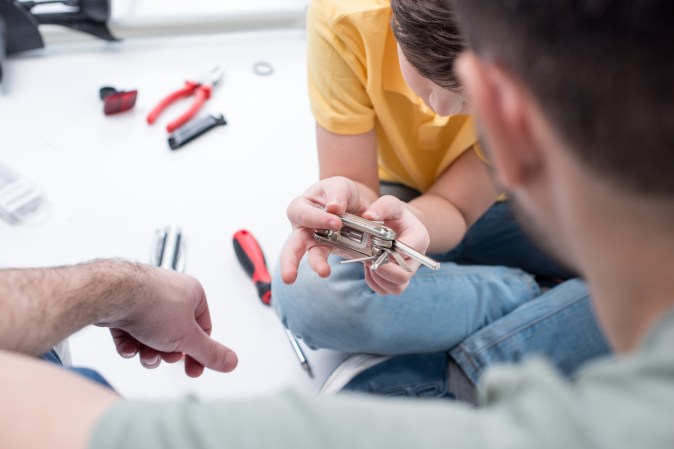

When I was in high school, I threw a Beanie Baby at a friend during a twisted version of dodgeball. He evaded, and the floppy collectible blew through a window screen and landed limply on the lawn. His parents paid someone a fair amount of money to fix the screen, but you don’t have to. You can do it yourself.
Repairing a screen is one of the simpler DIY home repair projects and usually takes less than 10 minutes, even if you don’t know a spline roller from a screwdriver. Most screens use fiberglass or aluminum screening held in place by something called spline: a rubber cord or piece of metal. When you attempt the fix, I recommend purchasing fiberglass screening because it’s easier to work with, but this guide will cover it all.
When buying screening, be sure to buy a roll a little larger than the frame. If you’ve got a screen frame that’s 32 inches wide, for example, you want your screening to be at least 34 inches wide. Trust me, working with material that barely fits the frame is enough to make you want to shove the whole thing right in the garbage. Prices vary by size and amount, but you can get 25 feet of 36-inch screening for $20 to $25.
Patching is always an option
Before starting, assess the damage. Got a large tear, or damage along the frame? Replace the screening entirely. But if you’re looking at a tear an inch or two long and you’d rather have a quick and easy fix instead of a flawless screen, just patch it.
I bought a pack of seven 2-by-2 inch aluminum patches for $3 at The Home Depot. Installing one took a bit of finagling as I struggled to get the longer wires on two of its four sides through the screen and pressed flat on the opposite side. Tricky, but it did the job.
I found it easier to simply apply an adhesive fiberglass patch, but at $3 to $10, you pay for the convenience. Some patches are self-adhesive; just peel ’em off and stick ’em on. Others, like the ScreenMend patches I bought, ($7 a pair at The Home Depot) require using a hairdryer to get the glue to set. After blasting it at close range for a minute or two, the 5-by-7-inch piece of mesh was secure. If there’s any loose screening flapping around, be sure to remove it or press it onto the adhesive patch, or the fix won’t stick properly.
Replacing a rubber-spline screen
What you’ll need:
- Flat-head screwdriver
- Screening (fiberglass)
- Spline (reused or new)
- Spline roller
- Utility knife
- Measuring tape (optional)
- Paper towels (optional)
So you’ve decided to repair the whole thing. Nice. Take a close look at the frame. See that narrow groove with what looks like a string in it? That string thing is called spline, and it comes out. Use a the screwdriver to pry it out of the channel. Start wherever the spline ends—usually at a corner. Once you’ve got it started, the rest should come out easily. Just pull on it. With that done, remove the damaged screening. Feel free to use a damp paper towel to wipe any grime off the frame.
If the spline is still soft and isn’t cracked or brittle, you can reuse it. If in doubt, replace it. It’s going to hold your screen in place, so you want it to be strong. Take a piece to the hardware store or measure its diameter so you know what size to buy. A roll of 100 feet can cost less you than $10. Remember, though, if you use screening thicker or thinner than the old stuff, you may have to adjust the spline size.
When you’re ready, roll the screening over the frame, leaving a few inches overhanging at each end, and cut if off to keep the roll out of your way.
Starting in any corner, press the spline into the groove with your finger. I suggest working on the short side of the screen first. Once you’ve got the spline positioned, use the concave wheel on the spline roller to slowly press the spline into the frame, slightly stretching it ahead of the tool to keep it from bunching. You can cut the spline when you reach a corner, but using one piece all the way around the frame makes it easier to reuse in the future.
If you don’t have a spline roller, buy one. A sturdy one made of wood and metal will cost you less than $10, and it’s worth the money.
“Could you do it with a screwdriver and your fingers? Sure. But you’ll inevitably slip off and damage the screen or get frustrated,” says Lou Manfredini, Ace Hardware’s home expert.
When you reach the final side, make sure the screening hasn’t rippled and pull it taut as you install the last of the spline. Don’t pull too tight, though, or you may bend the frame. Aligning the frame with a corner of your work surface can help ensure it stays straight. If you notice any mesh deformities, remove enough spline to correct the problem, smooth things out, and resume work.
Once you’ve got the last of the spline installed, use your knife to cut off any excess. Then trim the screen, keeping the knife at a 45-degree angle and the point facing away from the center of the screen. Take your time. You don’t want to slip and cut your new screen.
Replacing a metal-spline screen

What you’ll need:
- Flat-head screwdriver
- Hammer or rubber mallet
- Hard plastic putty knife
- Screening (fiberglass)
- Spline
- Utility knife
- Measuring tape (optional)
- Paper towels (optional)
- Rubber spline (optional)
If you don’t see a rubbery string framing your screen, but you do see long, thin pieces of metal, you’ve got metal spline. Your job just got a bit harder, because most metal spine screens weren’t designed for home repair. But don’t worry. With a little practice, you’ve got this.
Start with the thinnest screwdriver you can find. Pick a corner, slide the tool into the channel, and gently pry up a piece of spline from one end. Once you’ve lifted it a few inches, swap the screwdriver for the putty knife. Don’t have one? Any thin, sturdy piece of hard plastic will do. A metal tool like a pry bar or a chisel works too, but you risk scratching the frame.
Once you’ve got the tool positioned, hold the elevated end of the spline in one hand, as close to the frame as possible (this is important, as it will keep the spline from bending), and slowly slide the putty knife horizontally down the length of the spline. You’re trying to remove the spline without bending it too much, so you can’t just yank it out like rubber spline. If you do, it will curl and you’ll have to replace it. Keep it relatively straight and you should be able to straighten it by hand.
When you’ve removed all four spline pieces, take out the screening and clean the frame if necessary. Unroll the new screening over the frame, cut the roll free, and lay one of the short pieces of spline in position. Use your hammer or mallet to gently tap it into place, then use increasingly firmer strikes to set it. Placing a block of scrap wood between your hammer and the frame can mitigate denting, but I whacked the spline directly and didn’t notice any damage.
It’s important to note that a metal spline doesn’t seem to hold fiberglass screening as tightly as rubber spline does, and when I attempted to pull it tighter, I bent the screen frame. Your screen may be a bit loose, but it will still keep the bugs out. If you really don’t want to deal with metal spline, you could replace it with rubber spline using the instructions above, but finding some big enough could be tricky.
With the spline in place, trim the screen, Keep the knife at a 45-degree angle, with the point facing away from the center of the screen. Take your time. Don’t slice your new screen.
Working with aluminum screening
What you’ll need:
- Screening (aluminum)
- Spline (rubber or metal)
- Spline roller
- Utility knife
Working with aluminum screening is hard. Even professionals don’t like to do it. If you bend the mesh, you’ll either have to live with a lumpy screen or start over. If you’re a gamer, this is “hard mode.” That said, aluminum is stronger than fiberglass, which makes it more resistant to children and pets. If you’re concerned that even the sturdy fiberglass mesh designed to stand its ground against jumpy dogs isn’t up to the job, aluminum is worth considering.
If you’re determined to go with aluminum, start by removing the rubber or metal spline and damaged mesh as described above. Roll the new screening over the frame while keeping the mesh’s natural curve up, like a dome over the frame. This will help stop it from immediately rolling up when you cut it free from the roll with your utility knife.
Use the convex wheel on the spline roller to gently press the screening into the groove in the frame. Depending on how deep the channel is, you may have to make several passes. Be gentle; press too hard, and you risk tearing through the mesh. Keep the screening taut as you go; once you’ve rolled it into the frame, you won’t be able to undo it.
Working one side at a time, install your spline. I recommend using the rubber stuff, even though metal spline does better with aluminum screening than fiberglass. Then, use the concave wheel to press the tubing into the channel. If you’ve got to use metal spline, use a hammer or rubber mallet to tap it into place as described above.
Once you’ve installed the spline, trim the screen and admire what you’ve accomplished. And don’t let kids throw Beanie Babies in the house.















